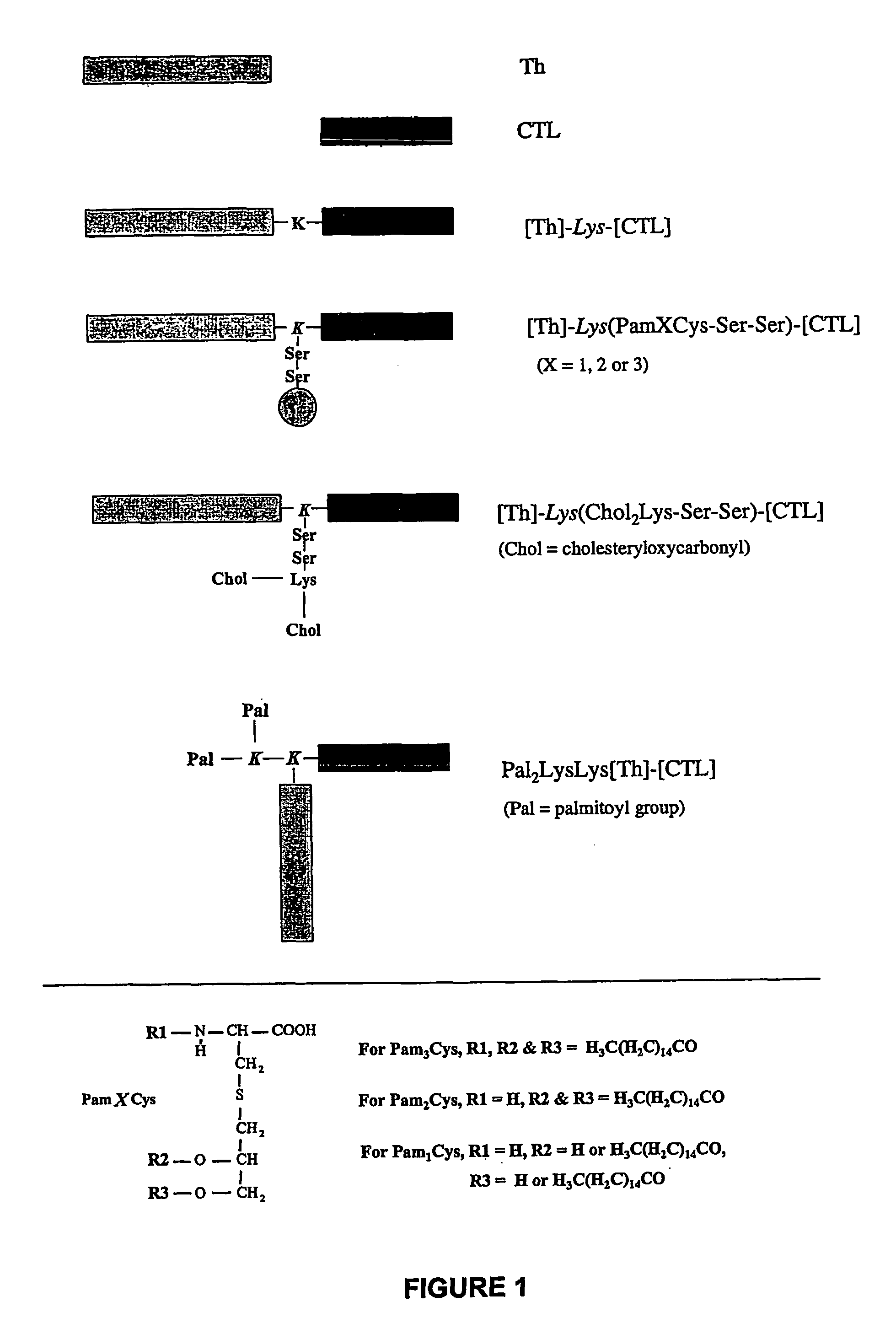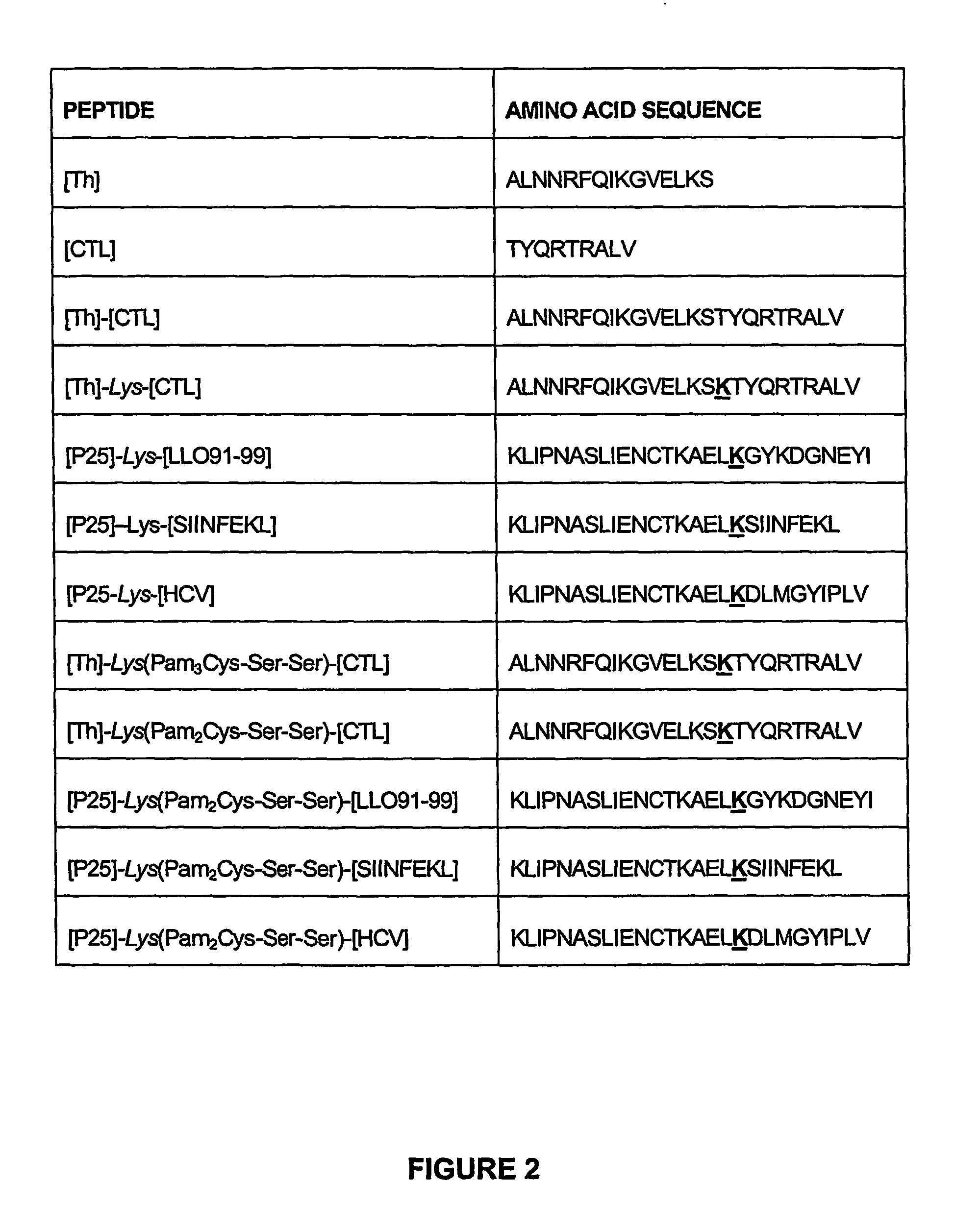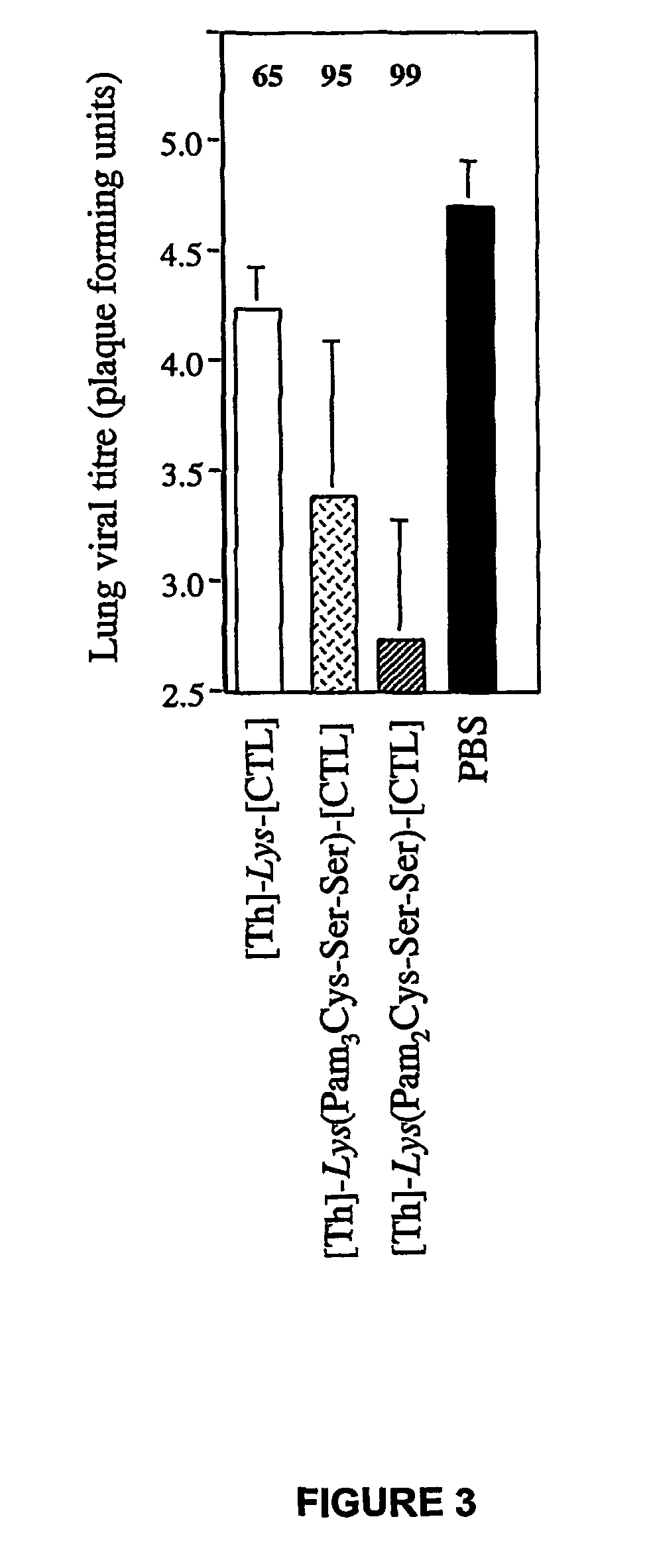Immunogenic lipopeptides comprising T-helper and cytotoxic T lymphocyte (CTL) epitopes
a lipopeptide and cytotoxic technology, applied in the field of immunology, can solve the problems of limited application and success of such treatments, synthetic peptides, and ineffective vaccine compositions
- Summary
- Abstract
- Description
- Claims
- Application Information
AI Technical Summary
Benefits of technology
Problems solved by technology
Method used
Image
Examples
example 1
Materials and Methods
Chemicals
[0261]Unless otherwise stated chemicals were of analytical grade or its equivalent. N,N′-dimethylformamide (DMF), piperidine, trifluoroacetic acid (TFA), O′benzotriazole-N,N,N′,N′-tetramethyluronium hexafluorophosphate (HBTU), 1-hydroxybenzotriazole (HOBt) and diisopropylethylamine (DIPEA) and diisopropylcarbodiimide (DIPCDI) were obtained from Auspep Pty. Ltd., Melbourne, Australia and Sigma-Aldrich Pty. Ltd., Castle Hill, Australia. O′benzotriazole-N,N,N′,N′-tetramethyluronium tetrafluoroborate (TBTU) was obtained from Bachem, (Bachem AG, Switzerland). Dichloromethane (DCM) and diethylether were from Merck Pty Ltd. (Kilsyth, Australia). Phenol and triisopropylsilane (TIPS) were from Aldrich (Milwaukee, Wis.) and trinitrobenzylsulphonic acid (TNBSA) and diaminopyridine (DMAP) from Fluka; 1,8-diazabicyclo[5.4.0]undec-7-ene (DBU) was obtained from Sigma and palmitic acid was from Fluka.
Viruses
[0262]The type A influenza viruses used in this study were an ...
example 2
Immunogenicity of Lipopeptides Comprising CTL Epitopes from Influenza Virus
[0299]Lipopeptides having a CTL epitope from influenza virus and in particular the lipopeptides [Th]-Lys(Pam2Cys-Ser-Ser)-[CTL] and [Th]-Lys(Pam3Cys-Ser-Ser)-[CTL], which comprise the amino acid sequence set forth in SEQ ID NO: 4 were tested for their ability to induce enhanced CTL-mediated viral clearance and to enhance dendritic cell maturation. As a negative control, a non-lipidated peptide having the amino acid sequence of SEQ ID NO: 4 was used in all experiments.
Viral Clearance
[0300]The lipopeptides elicited a higher level of viral clearance than non-lipidated peptides (FIGS. 3, 4a). Viral load in the lungs of mice primed with the lipopeptides and challenged with infectious Mem 71 virus 9 days later was reduced by 95% ([Th]-Lys(Pam3Cys-Ser-Ser)-[CTL]; FIG. 3) or 99% ([Th]-Lys(Pam2Cys-Ser-Ser)-[CTL]; FIG. 3) compared to samples from mice immunized with PBS alone. In contrast, non-lipidated peptide achieve...
example 3
Immunogenicity of Lipopeptides Comprising a CTL Epitope from L. monocytogenes
[0310]A lipopeptide having a CTL epitope from L. monocytogenes and in particular the lipopeptide [P25]-Lys(Pam2Cys-Ser-Ser)-[LLO91-99] comprising the amino acid sequence set forth in SEQ ID NO: 175 was tested for its ability to induce a CD8+ T cell response, and to protect against a challenge with L. monocytogenes. As a negative control, PBS or a non-lipidated peptide having the amino acid sequence of SEQ ID NO: 175 was used in all experiments. Isolated bacteria were used as a positive control.
IFN-γ Production by Splenocytes
[0311]The lipopeptide tested in this study induced a specific CD8+ T cell response against the immunizing CTL epitope, as evidenced by the enhanced number of IFN-γ producing splenocytes present in mice immunized with lipidated peptide relative to non-lipidated peptide. Mice immunized with 9 nmoles lipidated peptide vaccine [P25]-Lys(Pam2Cys-Ser-Ser)-[LLO91-99] comprising the amino acid ...
PUM
| Property | Measurement | Unit |
|---|---|---|
| area | aaaaa | aaaaa |
| pH | aaaaa | aaaaa |
| flow rate | aaaaa | aaaaa |
Abstract
Description
Claims
Application Information
 Login to View More
Login to View More - R&D
- Intellectual Property
- Life Sciences
- Materials
- Tech Scout
- Unparalleled Data Quality
- Higher Quality Content
- 60% Fewer Hallucinations
Browse by: Latest US Patents, China's latest patents, Technical Efficacy Thesaurus, Application Domain, Technology Topic, Popular Technical Reports.
© 2025 PatSnap. All rights reserved.Legal|Privacy policy|Modern Slavery Act Transparency Statement|Sitemap|About US| Contact US: help@patsnap.com



